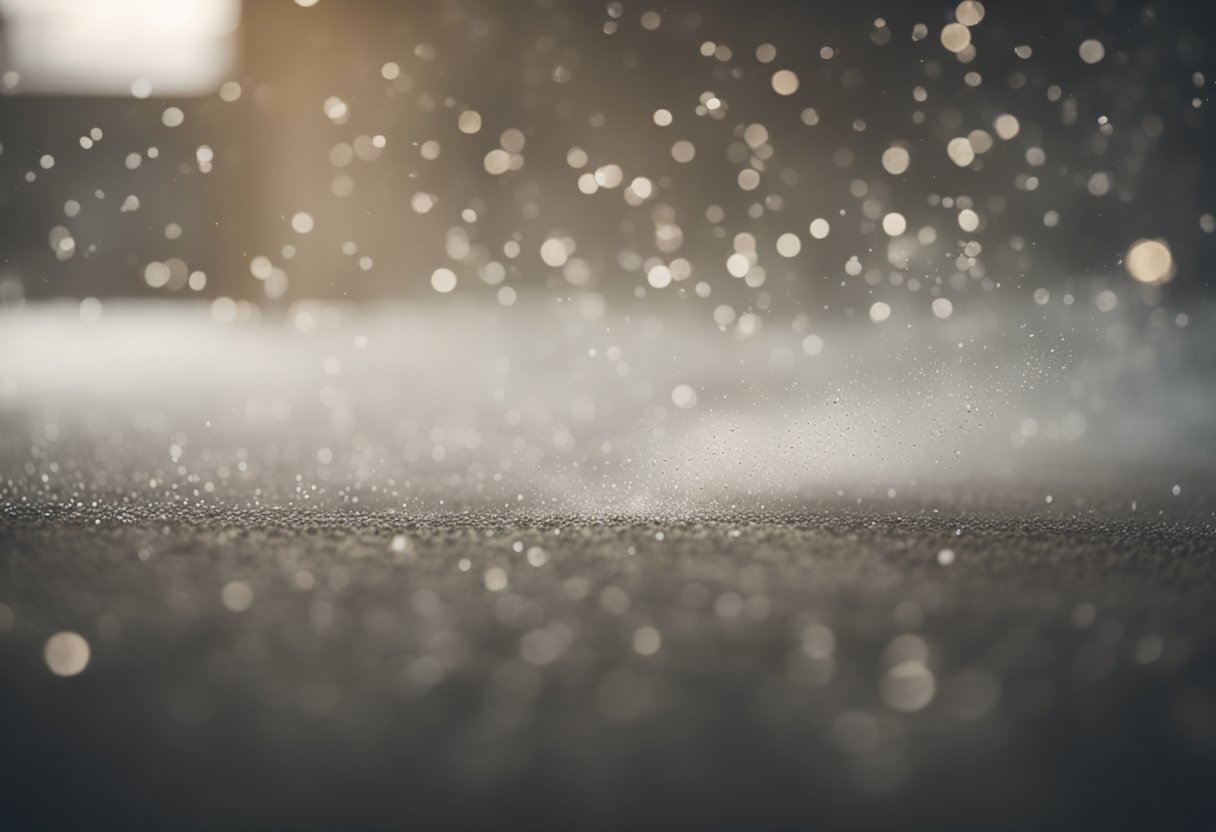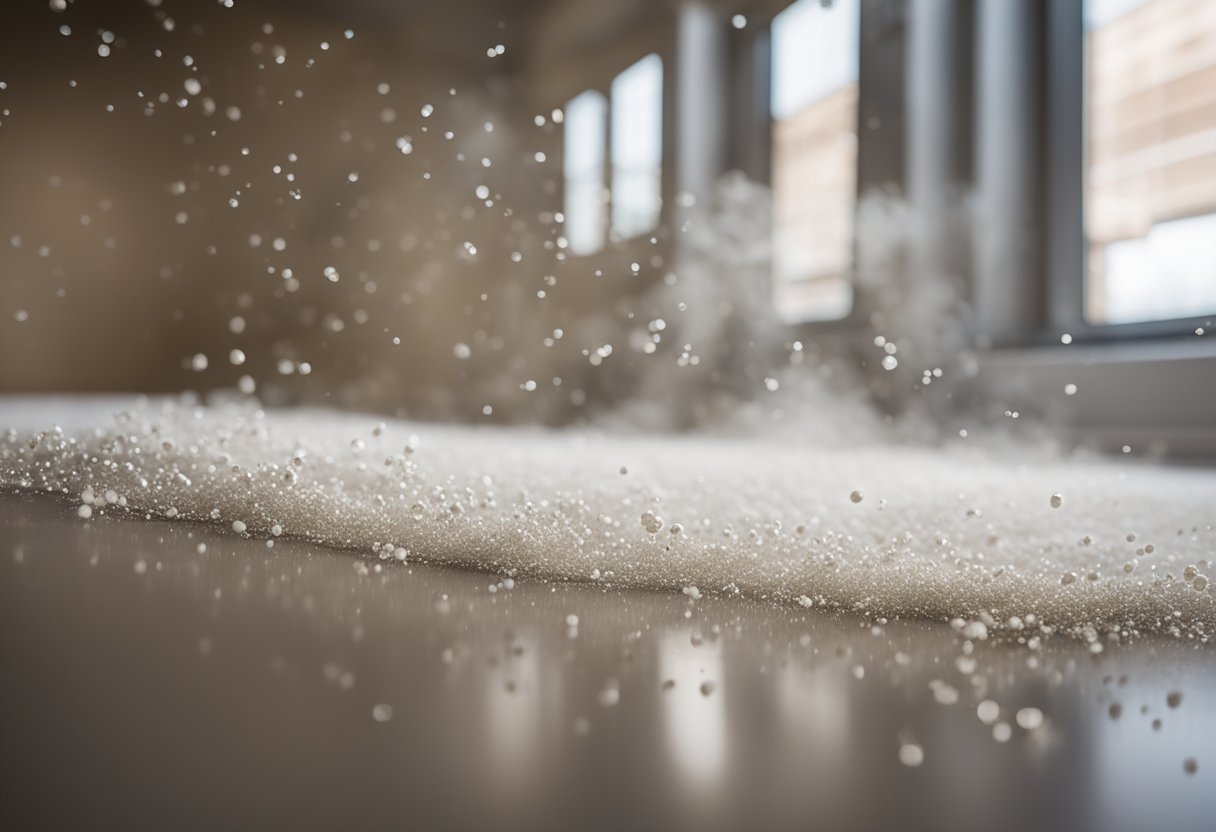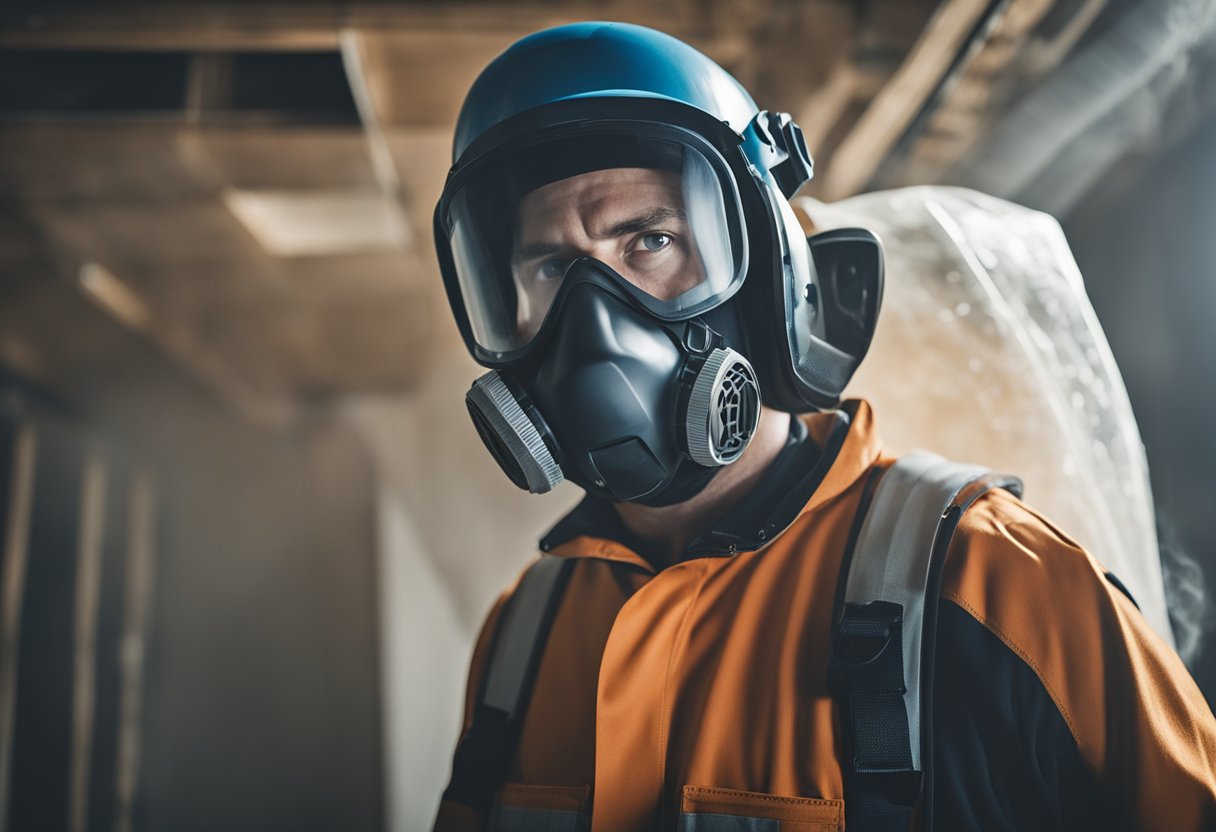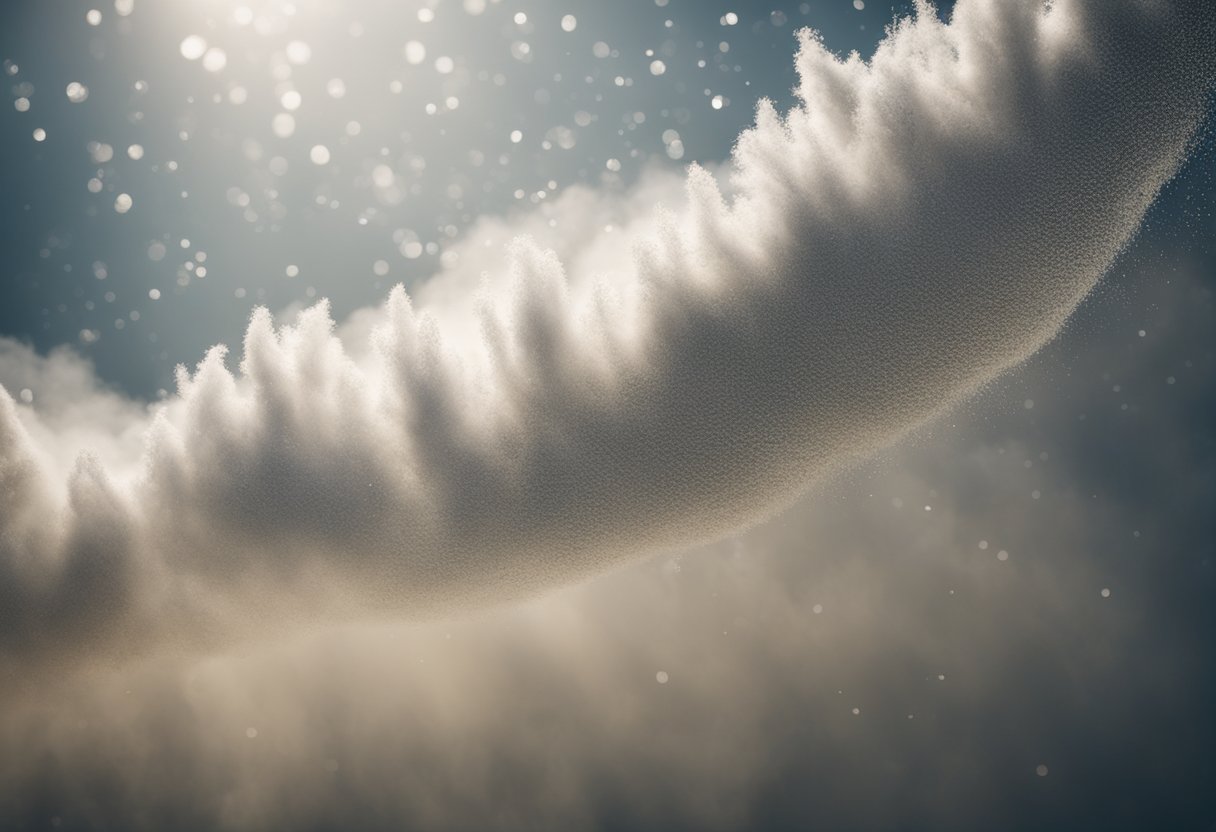Drywall is a popular building material used in construction projects. However, it creates a lot of dust when it’s being installed, sanded, or cut. Drywall dust is a mixture of gypsum, silica, and other minerals that can cause a variety of health problems if inhaled. It’s important to understand how long drywall dust stays in the air and how to prevent exposure to it.
Drywall dust can stay in the air for a long time, depending on various factors such as the size of the room, ventilation, and humidity. According to PlumbJoe, drywall dust can take up to 10-15 minutes to settle down. However, even small movements can kick the dust back up into the air, so it’s crucial to be careful during the cleaning process. It’s recommended to do a preliminary cleaning, wait another fifteen minutes, then do a final cleaning round.
In this article, I will provide an in-depth guide on understanding drywall dust, its health implications, and preventive measures to reduce exposure. I will also cover the drywall dust cleanup process and its impact on home systems. Additionally, I will provide answers to frequently asked questions related to drywall dust exposure.
Key Takeaways
- Drywall dust can stay in the air for up to 15 minutes and can cause various health problems if inhaled.
- Preventive measures such as using protective gear, proper ventilation, and containment can reduce the risk of exposure.
- Professional help and precautions should be taken when dealing with large amounts of drywall dust.
Understanding Drywall Dust
https://www.youtube.com/watch?v=FEmI5EKpWqI&embed=true
As a professional in the construction industry, I know that drywall dust is a common byproduct of cutting, sanding, and installing drywall. It is a mixture of various materials, including gypsum, mica, talc, and calcite, which are the primary ingredients in drywall.
When drywall is cut or sanded, the dust particles become airborne and can remain suspended in the air for a short period. According to my research, drywall dust only stays in the air for a few minutes, but it can be easily re-suspended if disturbed. This means that even after the visible dust has settled, there may still be particles in the air that are not immediately visible to the naked eye.
It is important to note that drywall dust can be harmful if inhaled in large quantities over an extended period. The dust particles are small enough to penetrate deep into the lungs and cause respiratory problems. Therefore, it is crucial to take proper precautions, such as wearing a dust mask and using proper ventilation, to minimize exposure to drywall dust.
In summary, drywall dust is a common byproduct of working with drywall that can be harmful if inhaled in large quantities. It is made up of various materials, including gypsum, mica, talc, and calcite, and can remain suspended in the air for a short period. Proper precautions, such as wearing a dust mask and using proper ventilation, should be taken to minimize exposure to drywall dust.
Drywall Sanding Methods
https://www.youtube.com/watch?v=RKuMMvy3sME&embed=true
When it comes to sanding drywall, there are a few different methods to choose from. Each method has its own benefits and drawbacks, so it’s important to choose the right one for your project. In this section, I’ll go over three of the most common drywall sanding methods: manual sanding, electric sanders, and vacuum sanders.
Manual Sanding
Manual sanding is the most traditional method of sanding drywall. It involves using a sanding pad or sandpaper to sand down the drywall by hand. While this method is simple and affordable, it can be time-consuming and tiring, especially if you have a large area to sand.
To manually sand drywall, start by using a coarse-grit sandpaper to remove any high spots or rough areas. Then, switch to a finer-grit sandpaper to smooth out the surface. Be sure to wear a dust mask and goggles to protect yourself from the dust.
Electric Sanders
Electric sanders are a popular choice for sanding drywall because they are fast and efficient. They come in a variety of sizes and styles, including orbital sanders, belt sanders, and disc sanders. Electric sanders are especially useful for large projects or for sanding hard-to-reach areas.
When using an electric sander, be sure to choose the right grit sandpaper for the job. Coarse-grit sandpaper is best for removing rough spots, while fine-grit sandpaper is better for smoothing out the surface. Always wear a dust mask and goggles when sanding with an electric sander.
Vacuum Sanders
Vacuum sanders are a newer technology that combines the benefits of electric sanders with a built-in dust collection system. These sanders use a vacuum attachment to capture the dust as you sand, keeping the air clean and reducing the amount of dust that settles on surfaces.
Vacuum sanders are especially useful for people with allergies or respiratory issues, as they can greatly reduce the amount of dust in the air. However, they are typically more expensive than other sanding methods.
In conclusion, there are several options for sanding drywall, each with its own benefits and drawbacks. Whether you choose manual sanding, an electric sander, or a vacuum sander, be sure to wear protective gear and choose the right grit sandpaper for the job.
Health Implications of Drywall Dust
https://www.youtube.com/watch?v=7bk4yyCIX74&embed=true
As a construction worker, I am well aware of the dangers of inhaling drywall dust. The dust generated from sanding or drilling drywall contains gypsum and silica, which can be harmful to the body if inhaled in large quantities. In this section, I will discuss the potential health implications of drywall dust.
Respiratory Issues
Inhaling drywall dust can irritate the respiratory tract, causing coughing, chest tightness, and shortness of breath. Prolonged exposure to drywall dust can lead to the development of respiratory diseases such as asthma and bronchitis. According to a recent study by the National Institute for Occupational Safety and Health (NIOSH), drywall sanders were exposed to as much as 10 times the permissible exposure limit (PEL) of 15 mg/m3 for total dust set by the Occupational Safety and Health Administration (OSHA) [1]. This highlights the need for proper ventilation and the use of personal protective equipment (PPE) such as masks.
Eye Irritation
Drywall dust can also cause eye irritation, redness, and tearing. It is important to wear eye protection when working with drywall to prevent dust particles from entering the eyes.
Long Term Health Risks
Prolonged exposure to drywall dust can lead to serious long-term health risks such as silicosis and lung cancer. Silicosis is a lung disease caused by the inhalation of crystalline silica dust. It can cause scarring of the lungs, leading to breathing difficulties and even death. According to a study by the Centers for Disease Control and Prevention (CDC), workers exposed to silica dust have an increased risk of developing lung cancer [3]. It is essential to take protective measures such as wearing a mask and using proper ventilation to minimize the risk of exposure to drywall dust.
In conclusion, the health implications of drywall dust cannot be overstated. Inhaling drywall dust can lead to respiratory issues, eye irritation, and serious long-term health risks such as silicosis and lung cancer. It is essential to take proper precautions when working with drywall, including wearing a mask and using proper ventilation. By doing so, we can protect ourselves from the harmful effects of drywall dust and ensure our long-term health and well-being.
[1] Control of Drywall Sanding Dust Exposures | NIOSH | CDC. (n.d.). Retrieved November 24, 2023, from https://www.cdc.gov/niosh/docs/99-113/default.html
[3] Silica | NIOSH | CDC. (n.d.). Retrieved November 24, 2023, from https://www.cdc.gov/niosh/topics/silica/default.html
Preventive Measures for Drywall Dust Exposure
https://www.youtube.com/watch?v=GVRvrOdB0eI&embed=true
When working with drywall, it is important to take preventive measures to minimize exposure to drywall dust. Here are some measures that I recommend:
Protective Gear
Wearing the appropriate personal protective equipment (PPE) is essential for minimizing exposure to drywall dust. A dust mask or respirator is necessary to prevent inhalation of drywall dust. It is recommended to use at least an N95 respirator to filter out the dust particles. Additionally, wearing gloves, goggles, and a long-sleeved shirt can help prevent skin irritation and eye damage.
Ventilation
Proper ventilation is crucial when working with drywall. I recommend using a high-efficiency particulate air (HEPA) filter to remove dust particles from the air. It is also important to ensure that there is adequate ventilation in the work area. Opening windows and doors and using fans can help circulate the air and reduce the concentration of drywall dust.
Sealing Off Work Area
Sealing off the work area can help prevent drywall dust from spreading to other areas of the building. I recommend using plastic sheeting and painter’s tape to create barriers around the work area. This will help contain the dust and prevent it from settling on surfaces in other parts of the building. It is also important to seal off vents and air ducts to prevent the dust from circulating throughout the building.
By following these preventive measures, you can minimize your exposure to drywall dust and reduce the risk of negative health effects. Remember to always wear the appropriate PPE, ensure proper ventilation, and seal off the work area to prevent dust from spreading.
Drywall Dust Cleanup Process
https://www.youtube.com/watch?v=ZLtx9eXGnxQ&embed=true
When it comes to cleaning up drywall dust, there are a few methods that work well. In this section, I will discuss the three main ways to clean up drywall dust: vacuuming, wet mopping, and air purification.
Vacuuming
Vacuuming is one of the most effective ways to clean up drywall dust. A vacuum with a HEPA filter is recommended to ensure that the dust is captured and not released back into the air. A shop vac can also be used, but it is important to make sure that the filter is clean and in good condition.
When vacuuming, it is important to use the right attachment. A crevice tool can be used to clean corners and tight spaces, while a soft brush attachment can be used for larger areas. It is also important to vacuum the walls and ceiling, as drywall dust can settle on these surfaces as well.
Wet Mopping
Wet mopping is another effective way to clean up drywall dust. It is recommended to use a damp mop or cloth, as dry methods can stir up the dust and make it airborne again. A solution of water and vinegar can also be used to help break down the dust.
When wet mopping, it is important to wring out the mop or cloth well to avoid leaving excess water on the floor. It is also important to change the water frequently to avoid spreading the dust around.
Air Purification
Air purification can be used in conjunction with vacuuming and wet mopping to help remove drywall dust from the air. An air purifier with a HEPA filter is recommended to ensure that the dust is captured and not released back into the air.
When using an air purifier, it is important to place it in the room where the drywall work was done and to run it continuously for a few days. It is also important to change the filter regularly to ensure that it is working effectively.
In conclusion, cleaning up drywall dust can be a time-consuming process, but it is important to do it properly to avoid health issues. Vacuuming, wet mopping, and air purification are all effective ways to clean up drywall dust, and using a combination of these methods can help ensure that the dust is completely removed.
Impact on Home Systems
HVAC System
Drywall dust can have a significant impact on the HVAC system in your home. The dust particles can get into the air ducts and clog them, which can reduce the efficiency of the system. This can lead to higher energy bills and a shorter lifespan for your HVAC system. In addition, the dust can also get into the air filter, which can reduce its effectiveness at removing other particles from the air.
To minimize the impact of drywall dust on your HVAC system, it is important to change your air filter regularly. This will help to prevent the filter from becoming clogged with dust, and will ensure that your HVAC system is running efficiently. You may also want to consider having your air ducts cleaned after any major renovation work, to remove any accumulated dust and debris.
Flooring
Drywall dust can also have an impact on the flooring in your home. If you have hardwood floors, the dust can settle on the surface and get ground into the finish, which can cause scratches and other damage. If you have carpet, the dust can settle into the fibers and be difficult to remove, which can lead to discoloration and a reduction in the lifespan of the carpet.
To minimize the impact of drywall dust on your flooring, it is important to cover the floors with drop cloths or plastic sheeting during the renovation work. This will help to prevent the dust from settling on the surface of the flooring. After the work is complete, it is important to thoroughly clean the floors to remove any remaining dust particles. If you have hardwood floors, you may also want to consider refinishing them after the renovation work is complete, to restore the finish and remove any scratches or other damage.
Professional Help and Precautions
When it comes to dealing with drywall dust, it’s always better to be safe than sorry. Hiring a professional to handle the installation or renovation process can prevent a lot of headaches down the line. Not only are professionals trained to handle the dust and debris that comes with drywall work, but they also have the proper equipment to contain and dispose of it safely.
If you do decide to take on the task yourself, make sure to take the necessary precautions. Wear a mask to prevent inhalation of the dust and goggles to protect your eyes. Cover any furniture or belongings in the area with plastic sheets to prevent dust from settling on them. It’s also a good idea to seal off the room with plastic sheeting to prevent the dust from spreading to other areas of the house.
Having a plan in place before starting the project can also help minimize the amount of dust that is released into the air. Use a vacuum with a HEPA filter to clean up dust as you work, and dispose of the debris in sealed bags. Avoid sweeping or using compressed air to clean up the dust, as this can cause it to become airborne again.
In conclusion, taking the necessary precautions and having a plan in place can help minimize the amount of drywall dust that is released into the air. Hiring a professional to handle the task is always the safest option, but if you do decide to take on the project yourself, make sure to wear protective gear and have a plan in place to contain and dispose of the dust safely.
Frequently Asked Questions
What is the recommended time to wait before entering a room with drywall dust?
It is recommended to wait at least 30 minutes after sanding or cutting drywall before entering the room. This will allow the dust to settle and reduce the risk of inhalation.
How long does it take for drywall dust to settle after construction?
According to PlumbJoe, drywall dust settles within a few minutes. However, some particles may remain in the air for up to several hours, depending on the amount of dust and ventilation in the room.
What are the health risks associated with breathing in drywall dust?
Breathing in drywall dust can cause irritation in the nose, throat, and lungs. Prolonged exposure to high levels of drywall dust can lead to more severe respiratory problems such as bronchitis, asthma, and silicosis. It is important to wear protective gear such as a mask and goggles when working with drywall.
What are some effective ways to clean up drywall dust?
According to Cleanse Hive, some effective ways to clean up drywall dust include using an air purifier, vacuuming all surfaces frequently, and using a damp cloth or mop to wipe down surfaces. It is important to avoid sweeping drywall dust, as this can cause it to become airborne and spread throughout the room.
Can drywall dust cause long-term respiratory problems?
Prolonged exposure to high levels of drywall dust can lead to long-term respiratory problems such as bronchitis, asthma, and silicosis. It is important to take protective measures such as wearing a mask and using proper ventilation when working with drywall to reduce the risk of respiratory problems.
How can I prevent drywall dust from spreading during construction?
To prevent drywall dust from spreading during construction, it is important to seal off the work area with plastic sheeting and use a HEPA filter in the HVAC system to trap dust particles. It is also important to wear protective gear such as a mask and goggles when working with drywall.

Hi, I’m Sal Muller of Tooltrip.com. My DIY experience led me to understand essential power tools for home projects. Tooltrip.com guides enthusiasts and professionals in choosing right tools for any job. I provide concise top tool reviews for easier, efficient DIY.





